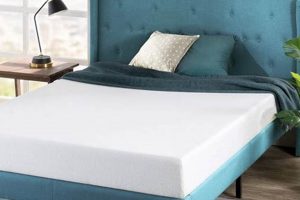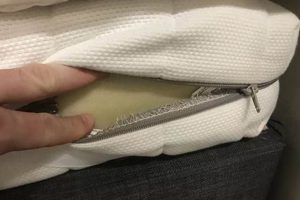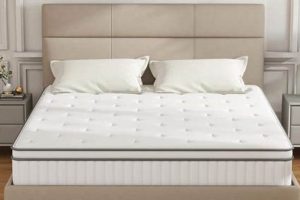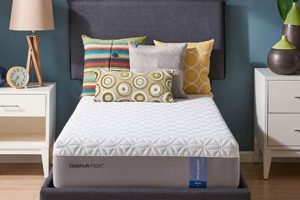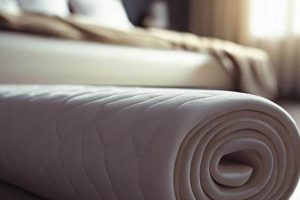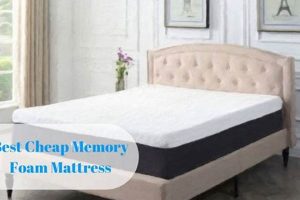The convergence of temperature regulation technology with viscoelastic foam represents a significant advancement in sleep surface design. This engineered material aims to mitigate heat retention, a common drawback of traditional foam, by incorporating elements that promote airflow and dissipate body heat. Such materials often integrate gel infusions, open-cell structures, or phase-change materials to maintain a comfortable sleeping temperature.
The significance of this innovation lies in its potential to improve sleep quality. Excessive heat during sleep can disrupt sleep cycles, leading to restlessness and decreased overall restfulness. By counteracting heat buildup, these sleep surfaces contribute to a more stable and conducive sleep environment. Historically, individuals have sought solutions to overheating during sleep, ranging from natural fiber bedding to rudimentary cooling systems. This contemporary approach offers a technologically advanced solution.
The subsequent discussion will delve into the specific technologies employed in constructing these advanced sleep surfaces, examine their performance characteristics, and consider the factors that influence their overall effectiveness in promoting cooler and more restful sleep.
Optimizing the Performance of Temperature-Regulating Viscoelastic Mattresses
The following recommendations are designed to enhance the effectiveness and longevity of mattresses engineered for thermal regulation. Adherence to these guidelines can contribute to a more comfortable and sustained sleep experience.
Tip 1: Employ a Breathable Mattress Protector: Selecting a protector constructed from materials such as cotton, bamboo, or Tencel will allow for optimal airflow through the mattress. Impermeable protectors can impede the cooling mechanisms, negating some of the intended benefits.
Tip 2: Utilize Bedding with Enhanced Airflow: Complement the mattress with sheets and blankets crafted from breathable fabrics. Natural fibers, such as linen or cotton with a low thread count, facilitate air circulation and minimize heat retention.
Tip 3: Maintain a Cool Bedroom Environment: A room temperature between 60-67 degrees Fahrenheit (15-19 degrees Celsius) is generally considered optimal for sleep. Adjusting the thermostat accordingly can significantly enhance the effectiveness of the mattress’s cooling properties.
Tip 4: Ensure Adequate Mattress Ventilation: Avoid placing the mattress directly on the floor. A slatted bed frame or a foundation that allows for airflow beneath the mattress prevents moisture buildup and promotes ventilation, which aids in temperature regulation.
Tip 5: Regularly Rotate the Mattress: Rotating the mattress periodicallytypically every three to six monthsensures even distribution of wear and prevents localized compression of the cooling components. This practice can extend the lifespan of the mattress and maintain its performance.
Tip 6: Address Underlying Health Conditions: Certain medical conditions and medications can contribute to night sweats or increased body temperature. Consulting a healthcare professional to manage these issues can further improve sleep quality.
Tip 7: Consider Individual Sensitivities: Personal temperature preferences vary. Experiment with different combinations of bedding and room temperature adjustments to determine the optimal configuration for individual comfort.
By implementing these strategies, individuals can maximize the advantages offered by advanced sleep surfaces and cultivate a more refreshing sleep environment. Consistent application of these practices will contribute to the sustained efficacy of the temperature-regulating features.
The subsequent section will explore the potential limitations and considerations associated with selecting and maintaining such mattresses.
1. Gel Infusion
Gel infusion represents a prominent method for enhancing the thermal properties of viscoelastic mattresses. By integrating gel materials into the foam matrix, manufacturers aim to mitigate heat retention, a known characteristic of conventional viscoelastic foam, thereby creating a cooler sleeping surface.
- Thermal Conductivity Enhancement
Gel-infused foam possesses superior thermal conductivity compared to standard viscoelastic foam. This characteristic facilitates the more efficient transfer of heat away from the sleeper’s body. Materials such as gel beads or gel swirls are often incorporated to achieve this improved heat transfer. For example, some manufacturers use a proprietary gel formulation with a specific thermal conductivity rating to quantify its effectiveness in heat dissipation. The implications include a reduction in overheating and a more consistent sleep temperature.
- Phase Change Material Integration
Certain gel infusions incorporate phase change materials (PCMs). These substances absorb or release heat as they transition between solid and liquid states at specific temperatures. When a PCM absorbs body heat, it changes from solid to liquid, thus cooling the mattress surface. As the temperature decreases, the PCM solidifies, releasing heat. This process helps regulate temperature fluctuations and maintains a more stable thermal environment. Examples include mattresses with microencapsulated PCMs integrated within the gel. The implications include a buffering effect against temperature swings during sleep.
- Density and Airflow Considerations
The density of the gel infusion and its impact on airflow are critical factors. High-density gel infusions may impede airflow, potentially counteracting some of the intended cooling benefits. Manufacturers often employ open-cell structures or strategically distribute the gel to mitigate this effect. For instance, gel beads may be spaced apart to allow for air circulation. The implications involve a trade-off between thermal conductivity and breathability, requiring careful design to optimize cooling performance.
- Durability and Long-Term Performance
The durability of the gel infusion and its long-term thermal performance are essential considerations. Over time, the gel material may degrade or lose its thermal properties, reducing its effectiveness. Factors such as the quality of the gel, the manufacturing process, and environmental conditions can influence durability. Examples include mattresses with gel infusions designed to maintain their cooling properties for a specified number of years. The implications involve the need for testing and quality control to ensure sustained cooling performance throughout the mattress’s lifespan.
The efficacy of gel infusion in enhancing the thermal properties of viscoelastic mattresses is dependent on several factors. Material selection, design considerations, and manufacturing processes collectively determine the ultimate cooling performance and durability of the sleep surface. While gel infusion can contribute to a cooler sleep environment, it is crucial to consider its limitations and potential trade-offs in te
rms of airflow and long-term performance.
2. Open-Cell Structure
Open-cell structure within viscoelastic foam is a critical determinant of thermal regulation, directly influencing the performance of mattresses designed to mitigate heat retention. The interconnected network of cells facilitates airflow, impacting breathability and heat dissipation.
- Enhanced Airflow Dynamics
The defining characteristic of open-cell foam is its interconnected cell structure. This allows for unimpeded airflow throughout the material, preventing the accumulation of heat. Traditional closed-cell foam, conversely, traps heat due to its lack of interconnectivity. An example includes comparing two identical foam samples, one open-cell and the other closed-cell, subjected to a controlled heat source; the open-cell sample will exhibit significantly lower surface temperature due to convective heat transfer. This enhanced airflow has implications for temperature regulation, reducing overheating during sleep.
- Moisture Evaporation Promotion
Open-cell structures facilitate the evaporation of moisture, including perspiration, which can contribute to overheating. The increased airflow allows moisture to escape from the mattress, creating a drier and more comfortable sleep surface. A relevant example is the use of open-cell foam in athletic apparel, where moisture wicking is crucial for maintaining comfort and performance. This promotion of moisture evaporation contributes to a cooler sleep environment, especially in humid climates.
- Density and Compression Considerations
While open-cell structure enhances airflow, the density of the foam still plays a significant role in overall performance. High-density open-cell foam may offer greater support and durability but can also restrict airflow to some extent. Manufacturers must carefully balance density and cell structure to optimize both support and cooling properties. For example, a mattress designed for heavier individuals may require higher density foam, necessitating a more aggressive open-cell design to maintain breathability. This highlights the need for a balanced approach to achieve optimal comfort and temperature regulation.
- Impact on Material Durability
The open-cell structure can potentially affect the long-term durability of the foam. The interconnected cells may be more susceptible to compression and degradation over time compared to closed-cell foam. However, advancements in foam manufacturing and material science have mitigated this concern. For instance, the incorporation of high-resilience materials and advanced manufacturing processes can enhance the durability of open-cell foam. Therefore, while potential durability considerations exist, modern manufacturing techniques have largely addressed these concerns.
The open-cell structure is fundamental to the effectiveness of temperature-regulating viscoelastic mattresses. Its influence on airflow, moisture evaporation, and overall breathability contributes significantly to creating a cooler and more comfortable sleep environment. Careful consideration of density, material properties, and manufacturing processes is necessary to optimize the benefits of open-cell technology and ensure long-term performance.
3. Phase Change Materials
Phase Change Materials (PCMs) are integral components in advanced sleep surface technology, specifically within the context of temperature-regulating viscoelastic mattresses. These materials possess the capacity to absorb or release thermal energy during phase transitions (e.g., solid to liquid or liquid to solid) at relatively constant temperatures. When integrated into viscoelastic foam, PCMs act as a thermal buffer, mitigating temperature fluctuations and maintaining a more stable sleeping environment. For example, microencapsulated PCMs can be embedded within the foam structure. As body heat increases, the PCM absorbs this excess energy during its phase transition, thereby cooling the immediate area. Conversely, when the body temperature decreases, the PCM releases stored heat, providing warmth.
The effectiveness of PCMs in viscoelastic mattresses depends on several factors, including the type of PCM used, the concentration within the foam, and the overall mattress construction. Different PCMs exhibit varying phase transition temperatures, influencing the range of temperature regulation. Furthermore, the method of incorporating PCMs, such as microencapsulation, impacts their durability and performance over time. Real-world applications demonstrate that mattresses incorporating PCMs can effectively reduce temperature-related sleep disturbances, leading to improved sleep quality, particularly for individuals prone to overheating during sleep.
In summary, the integration of PCMs into viscoelastic mattresses represents a significant advancement in thermal management technology. By absorbing and releasing heat, PCMs contribute to a more consistent and comfortable sleep temperature. However, the long-term efficacy of PCM technology relies on continued research and development to optimize material properties, enhance durability, and address potential limitations related to cost and manufacturing complexity.
4. Airflow Channels
Airflow channels, strategically integrated within viscoelastic mattresses, represent a design approach aimed at enhancing ventilation and dissipating heat. Their presence directly influences the microclimate of the sleep surface, impacting thermal comfort. The architecture of these channels, their placement within the mattress structure, and the materials used in their construction are key determinants of their efficacy.
- Convective Heat Transfer Enhancement
Airflow channels facilitate convective heat transfer by creating pathways for air to circulate within the mattress core. This allows for the removal of warm air accumulated near the body and the introduction of cooler air, thus reducing localized heat buildup. For example, channels running horizontally across the mattress surface can promote airflow even when the sleeper is in direct contact with the mattress. The implications of enhanced convective heat transfer include a reduction in skin temperature and a decrease in the likelihood of overheating during sleep.
- Moisture Management and Evaporation
Beyond heat dissipation, airflow channels contribute to moisture management by promoting the evaporation of perspiration. By increasing air circulation around the sleeper, these channels prevent the accumulation of moisture, which can lead to discomfort and disrupt sleep. An example is the inclusion of vertical channels that draw moisture away from the sleep surface and expel it through the sides of the mattress. The implications include a drier and more hygienic sleep environment, minimizing the potential for microbial growth and odor development.
- Channel Design and Material Considerations
The design of airflow channels, including their size, shape, and density, significantly impacts their effectiveness. Larger channels may provide greater airflow but could a
lso compromise the structural integrity of the mattress. The materials used in the channel construction, such as breathable fabrics or open-cell foam, further influence their performance. As an example, channels lined with moisture-wicking materials can enhance both airflow and moisture evaporation. The implications include the need for careful engineering to balance ventilation with support and durability. - Integration with Other Cooling Technologies
Airflow channels are often used in conjunction with other cooling technologies, such as gel infusions or phase change materials, to maximize their overall effectiveness. By providing a pathway for heat to be dissipated away from these cooling elements, airflow channels enhance their ability to regulate temperature. For example, channels positioned adjacent to gel-infused foam can facilitate the removal of heat absorbed by the gel. The implications include a synergistic effect, wherein the combination of technologies provides superior temperature regulation compared to any single technology alone.
The inclusion of airflow channels within viscoelastic mattresses represents a proactive approach to addressing the issue of heat retention. By facilitating convective heat transfer, promoting moisture evaporation, and complementing other cooling technologies, these channels contribute to a more comfortable and restorative sleep environment. The effectiveness of airflow channels is dependent on careful design, material selection, and integration with other cooling mechanisms.
5. Heat Dissipation
Effective heat dissipation is paramount in the design and functionality of viscoelastic mattresses engineered for temperature regulation. The capacity of these mattresses to effectively dissipate heat directly influences sleeper comfort and overall sleep quality. Various design and material innovations are implemented to optimize this process.
- Material Thermal Conductivity
The thermal conductivity of materials used in mattress construction significantly affects heat dissipation. Materials with higher thermal conductivity, such as copper-infused foam or certain gel formulations, facilitate the transfer of heat away from the sleeper’s body more efficiently than traditional viscoelastic foam. Examples include mattresses employing graphite-infused memory foam, known for its enhanced thermal conductivity. The implications of enhanced thermal conductivity are a cooler sleep surface and reduced risk of overheating.
- Convective Airflow Mechanisms
Convection, the transfer of heat through the movement of fluids (in this case, air), plays a crucial role in heat dissipation. Design elements such as open-cell foam structures, ventilation channels, and breathable fabrics promote airflow within the mattress, facilitating the removal of warm air and the introduction of cooler air. Mattresses with perforated foam layers or strategically placed air vents exemplify this approach. This enhanced airflow contributes to a more consistent sleep temperature and reduced moisture buildup.
- Radiative Heat Transfer Enhancement
Radiative heat transfer, the emission of thermal energy in the form of electromagnetic radiation, can be influenced by material properties. Certain materials, such as those incorporating phase change materials (PCMs), can absorb and release heat, effectively modulating radiative heat transfer and maintaining a stable temperature. An example is a mattress with a PCM layer that absorbs body heat during the initial phase of sleep and releases it as the body temperature decreases. The implications include a more stable and comfortable sleep environment throughout the night.
- Moisture Evaporation Facilitation
Moisture evaporation, the process by which liquid water transforms into vapor, is a significant mechanism for heat dissipation. Materials with enhanced moisture-wicking properties, such as specialized fabrics or open-cell foam structures, promote evaporation, removing heat from the body. Mattresses featuring covers made from breathable, moisture-wicking materials like Tencel are illustrative of this principle. The enhanced evaporation contributes to a drier and cooler sleep surface, reducing the likelihood of discomfort and disrupted sleep.
These facets of heat dissipation are intricately linked in the context of mattresses designed to regulate temperature. The synergistic application of thermally conductive materials, convective airflow mechanisms, radiative heat transfer modulation, and moisture evaporation facilitation collectively determines the mattress’s ability to maintain a comfortable sleep environment. Effective heat dissipation is thus a primary determinant of the overall performance and value of mattresses employing temperature-regulating technologies.
6. Moisture Wicking
Moisture wicking represents a critical function in mattresses designed to regulate temperature, particularly those incorporating viscoelastic foam. The presence of moisture can impede the thermal regulation capabilities of these mattresses, diminishing their effectiveness in maintaining a comfortable sleep environment. Therefore, the incorporation of moisture-wicking technologies is often a necessary component of mattresses marketed for their cooling properties.
- Fabric Construction and Composition
The composition and weave of the fabric encasing the mattress significantly influence its moisture-wicking capabilities. Fabrics constructed from synthetic materials, such as polyester microfiber, or natural fibers, like merino wool or Tencel lyocell, exhibit superior moisture-wicking properties compared to traditional cotton. These materials possess inherent capillary action, drawing moisture away from the body and facilitating its evaporation. The implementation of specialized weave patterns, such as knit structures, further enhances breathability and promotes airflow. The presence of these attributes in the mattress cover contributes directly to a drier and cooler sleep surface.
- Foam Permeability and Ventilation
The permeability of the viscoelastic foam core, coupled with engineered ventilation systems, affects the overall moisture management within the mattress. Open-cell foam structures promote air circulation, allowing moisture to evaporate from within the mattress layers. The integration of vertical or horizontal ventilation channels further enhances airflow, preventing moisture accumulation and reducing the potential for microbial growth. These features are particularly relevant in high-density viscoelastic foam, which tends to retain moisture more readily than other materials. The presence of these ventilation mechanisms can mitigate the adverse effects of moisture on the mattress’s cooling performance.
- Moisture-Wicking Finishes and Treatments
The application of specialized finishes and treatments to mattress components can further enhance their moisture-wicking capabilities. Hydrophilic coatings, for example, can increase the surface tension of fibers, promoting the absorption and subsequent evaporation of moisture. Antimicrobial treatments can also be integrated to inhibit the growth of bacteria and fungi, minimizing odors and maintaining a hygienic sleep environment. These treatments are often applied to the mattress cover or integrated directly into the foam
matrix. The use of these finishes contributes to a more comfortable and hygienic sleep surface, particularly for individuals prone to night sweats. - Interaction with Other Cooling Technologies
Moisture wicking works synergistically with other cooling technologies, such as gel infusions and phase change materials (PCMs), to optimize thermal regulation. By facilitating the evaporation of moisture, moisture-wicking materials prevent the dampness that can negate the cooling effects of these technologies. For example, a mattress with a PCM layer and a moisture-wicking cover will provide a more consistent and effective cooling experience than a mattress with PCM alone. This synergistic interaction underscores the importance of a comprehensive approach to temperature regulation in viscoelastic mattresses.
The integration of moisture-wicking technologies is not merely an ancillary feature but rather an essential component of mattresses designed for temperature regulation. The ability to effectively manage moisture directly impacts the overall cooling performance of the mattress, contributing to a more comfortable and restful sleep experience. Therefore, consumers seeking mattresses with enhanced cooling capabilities should prioritize those that incorporate robust moisture-wicking features.
7. Temperature Regulation
Temperature regulation is a primary design objective in viscoelastic mattresses intended to provide enhanced sleep comfort. The inherent properties of viscoelastic foam, while offering pressure relief and conforming support, tend to retain heat, potentially leading to discomfort and sleep disturbances. Therefore, mitigating heat retention through various technological and design interventions is crucial in the development of cooling viscoelastic mattresses.
- Material Composition and Conductivity
The thermal conductivity of the materials used in constructing viscoelastic mattresses directly influences temperature regulation. Traditional viscoelastic foam exhibits relatively low thermal conductivity, hindering heat dissipation. To address this, manufacturers incorporate materials with higher thermal conductivity, such as gel-infused foam, graphite-infused foam, or copper particles. These materials facilitate the transfer of heat away from the sleeper’s body, reducing localized heat buildup. An example is the utilization of open-cell viscoelastic foam, which enhances airflow and promotes convective heat transfer. The implication is a cooler sleep surface and a decreased risk of overheating.
- Airflow and Ventilation Systems
The implementation of airflow and ventilation systems within viscoelastic mattresses is essential for temperature regulation. Design elements such as ventilation channels, perforated foam layers, and breathable fabrics promote air circulation, enabling the removal of warm air and the introduction of cooler air. These systems enhance convective heat transfer, reducing humidity and maintaining a more consistent sleep temperature. A relevant example is the strategic placement of air vents along the perimeter of the mattress, facilitating the expulsion of warm air. The implications of effective airflow include a drier and more comfortable sleep environment.
- Phase Change Materials (PCMs) Integration
Phase change materials (PCMs) are employed to regulate temperature fluctuations within viscoelastic mattresses. PCMs absorb or release heat as they transition between solid and liquid states at specific temperatures, creating a thermal buffer that mitigates temperature swings. When integrated into viscoelastic foam, PCMs absorb excess body heat, preventing overheating, and release stored heat when the body temperature drops, maintaining a stable sleep temperature. An example is the use of microencapsulated PCMs embedded within the mattress cover. The implications include a more stable and comfortable sleep environment throughout the night.
- Moisture Management Technologies
Effective moisture management is crucial for maintaining thermal comfort within viscoelastic mattresses. Moisture accumulation can impede the performance of cooling technologies and create an environment conducive to microbial growth. Moisture-wicking fabrics, breathable mattress covers, and ventilation systems work in concert to remove moisture from the sleep surface, preventing dampness and promoting a drier sleep environment. An example is the use of fabrics constructed from synthetic microfibers or natural fibers like Tencel, known for their superior moisture-wicking properties. The implications include a more hygienic and comfortable sleep environment, minimizing the potential for odor development and microbial proliferation.
Temperature regulation in viscoelastic mattresses is a multifaceted challenge requiring the integration of advanced materials, innovative design elements, and effective moisture management strategies. The synergistic application of these technologies contributes to a cooling viscoelastic mattress that mitigates heat retention, promotes airflow, stabilizes temperature fluctuations, and manages moisture, ultimately providing a more comfortable and restorative sleep experience.
Frequently Asked Questions
The following addresses prevalent inquiries regarding viscoelastic mattresses engineered for temperature regulation, providing clarity on their composition, functionality, and suitability.
Question 1: What differentiates “cooling” viscoelastic foam from traditional viscoelastic foam?
The distinction lies primarily in the incorporation of materials and design elements that enhance heat dissipation and airflow. These modifications aim to counteract the inherent heat-retentive properties of standard viscoelastic foam, such as gel infusions, open-cell structures, and ventilation channels.
Question 2: How effective are gel infusions in regulating temperature within a viscoelastic mattress?
Gel infusions, particularly those incorporating phase change materials, contribute to temperature regulation by absorbing and dissipating heat. The efficacy of gel infusions varies based on the quality and concentration of the gel, as well as the overall mattress design.
Question 3: Do “cooling” viscoelastic mattresses eliminate the need for air conditioning?
No. While these mattresses enhance thermal comfort, they do not replace the necessity of maintaining an appropriate ambient temperature. Optimal sleep conditions typically involve a room temperature between 60-67 degrees Fahrenheit (15-19 degrees Celsius).
Question 4: How does open-cell structure contribute to temperature regulation in viscoelastic mattresses?
Open-cell structures promote airflow within the mattress, facilitating the removal of warm air and the introduction of cooler air. This enhanced ventilation helps prevent heat buildup and maintains a more consistent sleep temperature.
Question 5: What is the expected lifespan of the cooling properties in a “cooling” viscoelastic mattress?
The longevity of the cooling properties varies based on the quality of materials and manufacturing processes. High-quality mattresses may maintain their cooling performance for several years, while lower-quality options may degrade more rapidly. Regular maintenance, such as rotating the mattress, can extend its lifespan.
Question 6: Are there any potential drawbacks to “cooling” viscoelastic mattresses?
Some individuals may find that ”
cooling” viscoelastic mattresses do not provide sufficient cooling, particularly in hot climates or for those prone to night sweats. Additionally, the cost of these mattresses may be higher compared to traditional options. It is also worth noting that potential compression or damage to the mattress material over time can impact the cooling efficacy.
In summary, mattresses designed for thermal regulation offer solutions to sleep discomfort by promoting thermal comfort through material adaptation and structural design. The level of effectiveness and longevity are determined by production quality, materials, and use.
The following section will address maintenance and caring.
Conclusion
The preceding analysis has explored the facets of cooling mattress memory foam, outlining its constituent technologies, performance characteristics, and maintenance considerations. The integration of materials such as gel infusions, open-cell structures, and phase change materials, coupled with design innovations like airflow channels, collectively contribute to the regulation of temperature within the sleep environment. Effective implementation of these strategies aims to mitigate the heat-retentive properties of conventional viscoelastic foam, promoting improved sleep quality.
The advancements in sleep surface technology represented by cooling mattress memory foam underscore the ongoing pursuit of optimized sleep environments. Continued research and development in material science and design will further refine these technologies, potentially leading to more effective and durable solutions for thermal management during sleep. The significance of these innovations lies in their potential to improve overall well-being through enhanced sleep quality, meriting continued attention and investigation.


